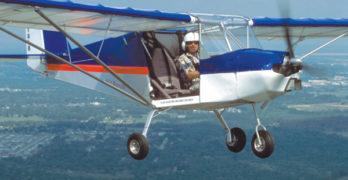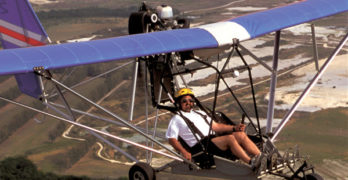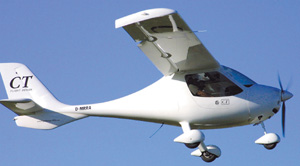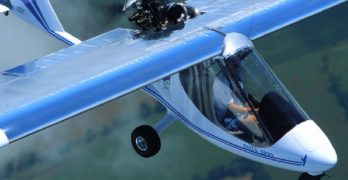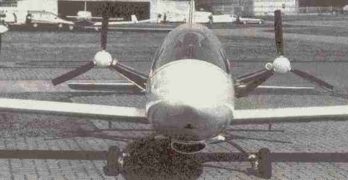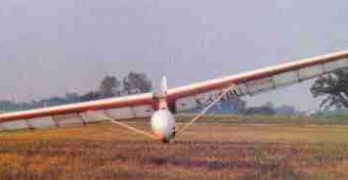One of the most popular club planes in France is widely used by instructors in that country. Now we welcome the Sky Ranger to North American skies.
In France, as with much of Europe, many ultralights are owned by aero clubs which frequently manage recreational airfields throughout the continent. Run a little differently in each location, they provide common ways for average pilots to fly and for newcomers to be introduced to flight. Virtually all aero clubs provide instruction, often through associated flight schools. Clubs also own and maintain aircraft – lots of them. This has worked especially well with sailplanes; Europe has more than twice as many sailplanes as the United States and several times the pilot population. Ultralight enthusiasts have followed this example.
The Sky Ranger arrived in the mid-1990s at French ultralight aero clubs that dot the landscape, and has done very well. U.S. importer Sabre Aircraft says, “It’s the most popular ultralight in France, especially with the flight schools.” In more than just 6 years, the company claims deliveries of about 500 aircraft.
Search Results for : powered parachute
Not finding exactly what you expected? Try our advanced search option.
Select a manufacturer to go straight to all our content about that manufacturer.
Select an aircraft model to go straight to all our content about that model.
M Squared’s Breese 2
Customers spoke and M-Squared acted. This proves the marketplace works, where customers “vote” with every dollar spent to acquire certain products. More importantly to pilots, this fact explains why a review of M-Squared’s new 2-seater – the Breese 2 – is good for customers.
Customers liked what M-Squared was doing. The 1996 company startup took a popular Quicksilver airframe design, added struts and beefed up the airframe to accept engines as large as the 100-hp Rotax 912S. But pilots also liked the way the original Quicksilvers (which are lighter) flew and handled. Being in business to serve customers, M-Squared acted appropriately.
Paul Mather and M-Squared responded to requests for a lighter version of their 2-seat Sport 1000 in a series of steps. First came the single-surface wing Sprint 1000, which dropped a few pounds by not using the big pod of the first Sport 1000. Then came the Breese SS (single-surface) and Breese DS (double-surface) single-seaters, which were obviously lighter and more agile.
Fixed -Wing or Flex-Wing
This month I wrote a pilot’s report about two widely different aircraft, both of which are imported by Rollison Airplane Company. Here’s how I handled it.
Every “Ultralight Flying! Pilot’s Report” has common elements: a main article, photos and photo legends, specifications, and our exclusive “Report Card.” Because the two subject flying machines are so different this month, I’ve prepared a “Report Card” for each aircraft. I did the same for specifications as the standard and optional features obviously differ too much for grouping.
In the main article, I take alternate looks at the two flying machines as a way to observe their differences, but further how they each have their benefits.
I also selected more photos – even though Ultralight Flying! reports regularly present many photos of ultralights being reviewed as readers often say that photos are a key informative element.
Because reviewing two different craft makes for a longer pilot report, I’ve somewhat abbreviated both the main article and the twin “Report Cards.”
Quite a few general aviation pilots recognize that ultralights offer a different way to fly| and that’s precisely what they like about them.
Titan Tornado
An Experimental ‘fighter jet’ that any pilot could love That vast majority of general aviation pilots who won’t even think about building their own plane has missed quite a revolution.
The FAA says approximately 25,000 aircraft are registered as Experimentals. That’s 15% of the GA fleet.
Building isn’t what it used to be. You no longer need to master the skill of reading engineering prints (plans), nor must you search high and low for parts.
These days, most registered Experimental aircraft are built from kits. Many are well-fabricated packages that can be assembled in just a few hundred hours. That can mean as little as two or three hours a night, two to three days a week, for about a half-year. Not a bad investment for a truly unique airplane.
One sport pilot who enjoys flying his creations is Minnesota resident Al Reay. For Reay, building is a means to an end.
Super Magnum
The Super Magnum packs an 80-horse four-stroke Verner Some general aviation pilots are put off by ultralights; for others they’re great fun.
If you’re the type who likes the idea of ultralight flight but you don’t trust the common two-stroke engines, then Sport Flight’s Super Magnum kit-built aircraft with the Verner engine may be what you’re looking for.
JOIN THE FAMILY
For nearly a decade, Sport Flight Aviation has produced the Talon XP two-seater and the Magnum single-seater. In 1998 the company added the Super Magnum, a one-place airplane that features a substantial 80-horsepower engine from the Czech Republic.
The Verner SVS-1400 engine was brought to the United States by Milan Stavenik in the mid-1990s. Milan lost his life in an accident unrelated to the Verner, but development of the engine has continued under Sport Flight Aviation owner Roger Bitton.
In addition to the Verner, the new HKS 700E, imported from Japan by Hpower, is enjoying a good reception.
Albatros
A dashing hybrid from the European microlight scene European microlight designers are blazing new runways to the sky.
Two decades after the first powered hang gliders were turned into powered ultralights, companies now offer two styles of aircraft. As one would expect, many ultralight designers have evolved their airplanes in new ways.
These producers now offer flying machines that employ the best ideas of familiar old designs (such as sewn Dacron wings and aluminum-tubing main structures), but they combine these tried and true components with composite fuselages and welded steel parts. Many variations on this theme keeps a wide range of aircraft in the pipeline.
Taking a different approach are those designers who are emerging from the world of kit-built designs. Some developers have conventional general aviation or airline design backgrounds. Whatever their experience, these engineers create clean-sheet designs that have evolved since the early days of aviation design.
As each tries to create a new microlight, they are not bound by any traditions, other than the laws of aerodynamics.
Gull flying in a new millenium
It is Mark’s design philosophy to make the most efficient aircraft he can, one that will use the least fuel. He defines himself as “a minimalist,” and this sentiment is carried throughout this beautifully optimized aircraft.
To me, Mark appears to have grown increasingly comfortable in his role within ultralight aviation. Relaxed and confident, he knows he has created a superior flying machine.
He also smiles a lot more these days in my opinion, thanks to a wonderful woman named Leslie who accompanied him to AirVenture 2000 in Oshkosh, Wisconsin. Married a year and a half ago, the two complement each other and make a good team.
No more tight squeezes
Perhaps it was this new personal relationship that motivated Mark to pay more attention to creature comforts. Notably, the Gull 2000 is wider than the previous single-seat or tandem two-seat Thunder Gull aircraft. Considering Mark is a lean and healthy vegetarian, his concern for broader pilots is no doubt appreciated.
FK-11
Let’s check out the FK-11 ultralight.
How would you like to own a Mercedes-brand ultralight? Today you can’t, and maybe you will never be able to, but you may be able to purchase a slick little ultralight called the FK-11 that is well known to Mercedes. And if you want a Mercedes-powered ultralight today, one is being sold.
This month’s “Light Stuff” again ventures across the Atlantic to look at another fascinating aircraft coming from the European sport aircraft community. The pictures accompanying this column feature the FK-11, a prototype design from Otto Funk, lead designer for the German ultralight manufacturer, B&F Technik Vertriebs.
B&F is what Americans might call a family operation. Son Peter Funk runs the business. Otto is his father, who owns an engineering firm and works with Peter as B&F’s design team. Before starting his own enterprise, Otto was an engineer working for Airbus.
Twin-Prop FK-11
The FK-11 is a single-engine ultralight using two aft-mounted props that extend from the fuselage midsection on upward-angled supports.
Marske Sailplanes
The Marske Monarch continues to offer economical soaring.
Ultralight sailplanes. Are they a new category of aviation, a segment of ultralight aircraft or just little sailplanes? Though ultralights seem to be some of the newer aircraft in general aviation, their true lineage is based on soaring machines.
For example, the first and still most successful ultralights, the Quicksilver series, came from a hang glider design to which a small engine was added back in the 1970s. Trikes, which have continued to grow in worldwide popularity, are based on delta-wing hang gliders to which power and landing gear were added. Therefore, though the term may be relatively new (going back a decade or so), the aircraft has a longer heritage. One shining example of this is Jim Marske’s Monarch.
New Model, Old Design
Marske has been building the Monarch for 20 years and has added his higher performance model, the Pioneer, to his list of designs spanning 40 years.
- « Previous Page
- 1
- …
- 43
- 44
- 45


